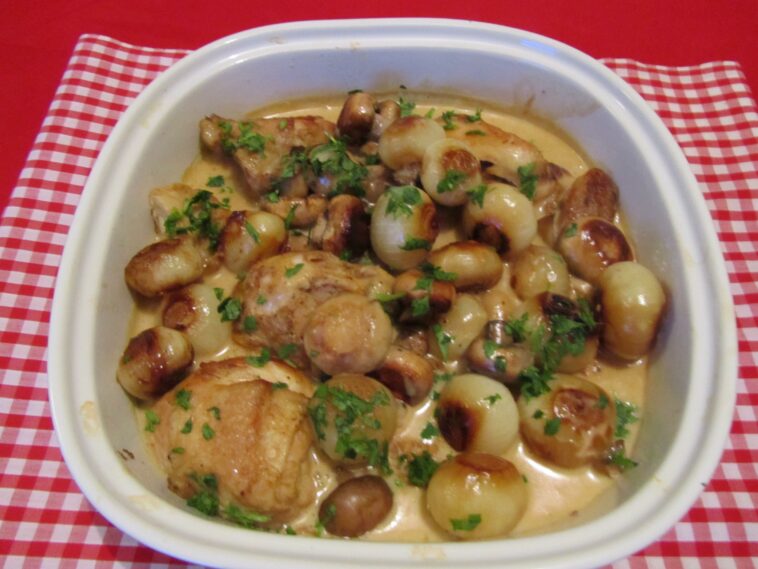Hühnerfrikassee Recipe
- Introduction
- Introduce Hühnerfrikassee.
- Mention its popularity in German cuisine.
- Historical Background and Cultural Significance
- Trace the origins of chicken fricassee.
- Discuss its adaptation into German cuisine as Hühnerfrikassee.
- Ingredients and Their Importance
- Detailed list of ingredients.
- Explain the role of each ingredient in the dish.
- Step-by-Step Cooking Guide
- Detailed instructions for preparing Hühnerfrikassee.
- Include tips and techniques for each step.
- Nutritional Analysis
- Breakdown of the nutritional content of Hühnerfrikassee.
- Discuss healthier ingredient substitutions.
- Serving and Pairing Suggestions
- Recommend side dishes and pairings.
- Presentation and garnishing tips.
- Variations of the Recipe
- Different regional and modern twists on Hühnerfrikassee.
- Include vegetarian/vegan alternatives.
- Storage and Reheating Guidelines
- Best practices for storing and reheating leftovers.
- Common Mistakes and Troubleshooting
- Address potential cooking issues and their solutions.
- FAQ Section
- Answer commonly asked questions about the recipe.
- Conclusion
- Summarize the appeal of Hühnerfrikassee.
- Encourage readers to try making it at home.
Partial Article Write-Up
Introduction
Hühnerfrikassee, a classic dish in German cuisine, is a comforting and creamy chicken stew that has been savored for generations. Known for its delicate flavor and hearty consistency, this dish is a staple in many German households and is often associated with family gatherings and festive occasions.
Historical Background and Cultural Significance
The concept of fricassee, which involves cooking meat in a white sauce, dates back centuries and is prevalent in many European cuisines. In Germany, Hühnerfrikassee became a beloved variant, utilizing local ingredients and cooking traditions. This dish not only reflects the culinary heritage of the region but also showcases the adaptability and evolution of European cooking methods.
Ingredients and Their Importance
The key to an authentic Hühnerfrikassee lies in its ingredients. Central to the dish is chicken, which is typically poached and then cooked in a creamy sauce made from the chicken broth, butter, flour, and cream. Vegetables like carrots, leeks, and mushrooms add texture and depth of flavor, while a hint of lemon juice provides a subtle zest. Each ingredient contributes to the overall harmony and richness of the dish.
Step-by-Step Cooking Guide
Preparing Hühnerfrikassee involves several steps that culminate in a rich and flavorful dish. The process starts with poaching the chicken, followed by preparing a roux-based sauce using the poaching liquid. Vegetables are then sautéed and combined with the chicken and sauce. The article would provide detailed instructions, ensuring that even novice cooks can successfully prepare this dish.
Nutritional Analysis
While Hühnerfrikassee is a rich dish, it can be part of a balanced diet. The article would offer a nutritional breakdown and suggest ways to make a lighter version, such as using low-fat cream or increasing the proportion of vegetables.
Serving and Pairing Suggestions
Traditionally, Hühnerfrikassee is served with rice or boiled potatoes, making for a filling and satisfying meal. Suggestions for complementary side dishes, such as steamed vegetables or a crisp salad, would be included to balance the creaminess of the fricassee. Wine pairing suggestions could also enhance the dining experience.
Variations of the Recipe
The versatility of Hühnerfrikassee allows for various adaptations. The article would explore regional variations, modern interpretations, and even vegetarian alternatives, ensuring that the recipe caters to a wide range of tastes and dietary preferences.
Storage and Reheating Guidelines
Proper storage and reheating techniques are crucial for maintaining the quality and safety of leftovers. The article would provide tips on how to store and reheat Hühnerfrikassee without compromising its texture and flavor.
Common Mistakes and Troubleshooting
Common issues, such as preventing the sauce from curdling or ensuring the chicken remains tender, would be addressed, providing solutions and tips to avoid these pitfalls.
FAQ Section
This section would answer frequently asked questions, such as how to adjust the thickness of the sauce, suitable chicken cuts for the recipe, and how to make a dairy-free version


